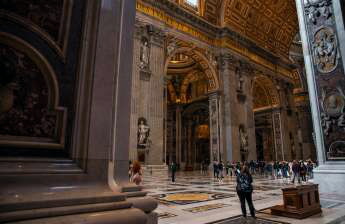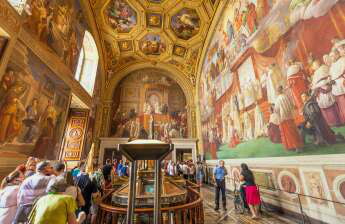If you're planning a trip to Rome, the Vatican Museums should be high on your list. They're home to some of the world's most priceless pieces of art, and are a must-visit for any art lover.
Make sure to wear comfortable clothing and shoes, and don't forget to pack light! The galleries are huge and can get crowded.
The Sistine Chapel
The Sistine Chapel is one of the most famous sites in all of Rome and the Vatican. It's a masterpiece of the Renaissance and people flock from all over the world to see the ceiling and altar frescoes.
Michelangelo's The Creation of Adam is the most prominent image in the Sistine Chapel, but there's more to this magnificent space than just a single painting. It's decorated from floor to ceiling by several of the greatest names in Renaissance art.
To get to the Sistine Chapel, you must first visit the Vatican Museums. These galleries are large and full of treasures, and you'll need at least two hours to explore them fully.
A guide will help you navigate the vast complex, explaining its history and art and sharing plenty of stories along the way to keep you engaged and entertained. A tour with a guide is a must-have for anyone looking to visit the Sistine Chapel or the entire Vatican Museums.
The Gallery of Maps
The Gallery of Maps is one of the most interesting and impressive parts of the Vatican Museums. It is home to a stunning collection of 40 maps of Italy, all painted in the 1580s by the famous Dominican and cartographer Ignazio Danti.
Located directly underneath the Sistine Chapel, this 120 meter long gallery is home to some of the world's most beautiful and intricate maps of Italy. They are a must-see for anyone interested in geography and Renaissance history.
These maps are a fascinating glimpse into the past and will leave you wondering what it would be like to live in that time. You'll also find a few maps that are a little weird, such as the map of Sicily that is upside down!
The Gallery of Tapestries
The Gallery of Tapestries is one of the most breathtaking sections at the Vatican Museums. With walls covered in intricately woven tapestries, this is a must-see for anyone interested in art, history, and culture.
The gallery houses two series of tapestries, dating back to the 16th and 17th century. The left wall displays tapestries that are based on drawings by Raphael, while the right side contains a set of seventeenth-century tapestries depicting episodes in the life of Pope Urban VIII.
Another tapestry in this room is the Supper at Emmaus, which tells the story of Jesus meeting his Apostles after he rose from the dead. This tapestry was originally hung in the Sistine Chapel until it was moved to this gallery in 1838.
The Vatican Museums has several departments that work on the conservation and restoration of these artifacts. These include the Tapestry and Textiles Restoration Laboratory, Painting and Wood Materials Restoration Laboratory, Ethnological Materials Restoration Laboratory, Stone Materials Restoration Laboratory, Metals and Ceramics Restoration Laboratory, Mosaic Restoration Laboratory, and Paper Restoration Laboratory.
The Library of Raphael
One of the most important rooms at the Vatican Museums is the Library of Raphael. It is home to some of the world's most famous paintings, including the Disputation on the Holy Sacrament, which Raphael began painting when he was just 25 years old.
The Raphael Rooms are located on the second floor of the Vatican Palace (third floor for Americans) and overlook the Belvedere Courtyard. They were originally part of Pope Julius II’s private apartments and were frescoed by Raphael and his students between 1508 and 1524.
In the Stanza di Constantine, for example, you can see the Vision of the Cross and the Baptism of Constantine. The room is named after the first Christian Emperor who recognized Christianity and granted freedom of worship to his people.

